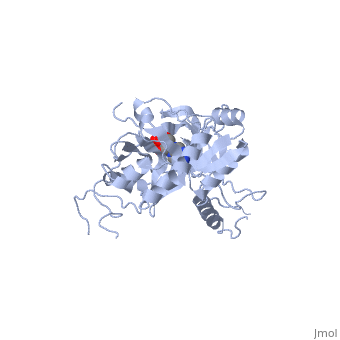ATP-dependent DNA ligase from bacteriophage T7
From Proteopedia
(Difference between revisions)
| Line 3: | Line 3: | ||
==Overview (General Function)== | ==Overview (General Function)== | ||
| - | ATP-dependent DNA ligase from bacteriophage T7 (Caudovirales Podoviridae) is used to catalyze a phosphodiester bond between single-strand nicks in double-stranded DNA. This occurs in replication (connecting okazaki fragments), DNA repair (excision repair), and recombination. DNA ligases require either ATP (eukaryotes and viruses) or NAD+ (prokaryotes) as a cofactor. All ligases require a divalent cation for function. Bacteriophage T7 DNA ligase uses Magnesium in vivo. A range of pH 7.2-7.7 is ideal for enzymatic activity. T7 ligase has a molecular weight of 41 kDa. | + | ATP-dependent DNA ligase from bacteriophage T7 (Caudovirales Podoviridae) is used to catalyze a phosphodiester bond between single-strand nicks in double-stranded DNA. This occurs in replication (connecting okazaki fragments)<ref name="Berg">Berg, Jeremy M, Stryer, Lubert, Tymoczko, John L. ''Biochemistry.'' Sixth edition. New York: W.H. Freeman and Company, 2007: 796. Print.</ref>, DNA repair (excision repair), and recombination. DNA ligases require either ATP (eukaryotes and viruses) or NAD+ (prokaryotes) as a cofactor. All ligases require a divalent cation for function. Bacteriophage T7 DNA ligase uses Magnesium in vivo. A range of pH 7.2-7.7 is ideal for enzymatic activity. T7 ligase has a molecular weight of 41 kDa. |
Revision as of 02:04, 7 November 2013
ATP-DEPENDENT DNA LIGASE FROM BACTERIOPHAGE T7
| |||||||||||
References
- ↑ Berg, Jeremy M, Stryer, Lubert, Tymoczko, John L. Biochemistry. Sixth edition. New York: W.H. Freeman and Company, 2007: 796. Print.
Proteopedia Page Contributors and Editors (what is this?)
William Guthrie, Hunter Douglas, Jeremy A. Hammett, Jaime Prilusky

